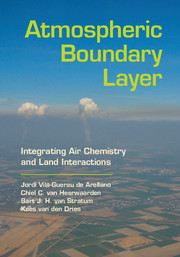Book contents
- Frontmatter
- Contents
- CLASS Software
- Preface
- Acknowledgments
- Part I The Land-Atmospheric Boundary Layer System
- Part II The Uncoupled System
- 2 Atmospheric Boundary Layer Dynamics
- 3 Atmospheric Boundary Layer Chemistry
- 4 Potential Temperature Budget: Diurnal Variation of Temperature
- 5 Moisture Budget: Diurnal Variation of Specific Moisture
- 6 Momentum Budget: Diurnal Variation of Wind
- 7 Scalar and CO2 Budget: Contributions of Surface, Entrainment, and Advection
- 8 Reactant Budget: Diurnal Variation of Ozone
- Part III The Coupled System
- Part IV Processes Related to Boundary Layer Clouds
- Part V User's Guide: CLASS Modules and Variables
- Appendices
- Bibliography
- Index
6 - Momentum Budget: Diurnal Variation of Wind
from Part II - The Uncoupled System
Published online by Cambridge University Press: 05 July 2015
- Frontmatter
- Contents
- CLASS Software
- Preface
- Acknowledgments
- Part I The Land-Atmospheric Boundary Layer System
- Part II The Uncoupled System
- 2 Atmospheric Boundary Layer Dynamics
- 3 Atmospheric Boundary Layer Chemistry
- 4 Potential Temperature Budget: Diurnal Variation of Temperature
- 5 Moisture Budget: Diurnal Variation of Specific Moisture
- 6 Momentum Budget: Diurnal Variation of Wind
- 7 Scalar and CO2 Budget: Contributions of Surface, Entrainment, and Advection
- 8 Reactant Budget: Diurnal Variation of Ozone
- Part III The Coupled System
- Part IV Processes Related to Boundary Layer Clouds
- Part V User's Guide: CLASS Modules and Variables
- Appendices
- Bibliography
- Index
Summary
In collaboration with Joel Schröter
Atmospheric horizontal flow (hereafter “wind”) is a key fundamental meteorological phenomenon associated with important large-scale atmospheric structures. Wind is responsible for the large- and small-scale transport of atmospheric mass, energy, water, and atmospheric constituents that determine weather and the climate on Earth.
In order to understand atmospheric wind dynamics (represented by the physical quantity momentum) we need to study the momentum budget in the ABL. This budget enables us to identify and quantify the contribution of the drivers that accelerate and decelerate an air mass. These drivers are pressure gradient forcing, rotation of the Earth, advection due to wind velocity gradients, and surface friction due to turbulence. The driver related to the Earth's rotation is completely independent of time, but its specific contribution to the horizontal flow, represented by the Coriolis force, depends on the geographical latitude. The horizontal gradients of pressure and velocity are typically associated with larger synoptic and meso-scale spatial patterns. These pressure gradients govern the wind in the free troposphere and are the main force of the wind in the ABL (similar to the sensible heat flux for the potential temperature budget). In our modelling framework, we assume that their time-scales are longer (several days) than the time-scales of the ABL (diurnal scale). Similarly, horizontal mean wind advection is assumed to be governed by atmospheric flows driven by synoptic- and/or meso-scale phenomena. Here, we focus on changes in the wind due to boundary-layer processes.
Within the ABL, the atmospheric flow is subjected to surface friction, and therefore the ABL wind velocity (speed and direction) systematically deviates from the wind velocity in the free troposphere. As the friction at the surface leads to loss of momentum, wind speed in the ABL is generally lower than in the free troposphere. The strong influence of surface friction combined with the convective turbulence results in another typical feature of the wind in the ABL: strong diurnal variations in wind speed.
- Type
- Chapter
- Information
- Atmospheric Boundary LayerIntegrating Air Chemistry and Land Interactions, pp. 62 - 84Publisher: Cambridge University PressPrint publication year: 2015



